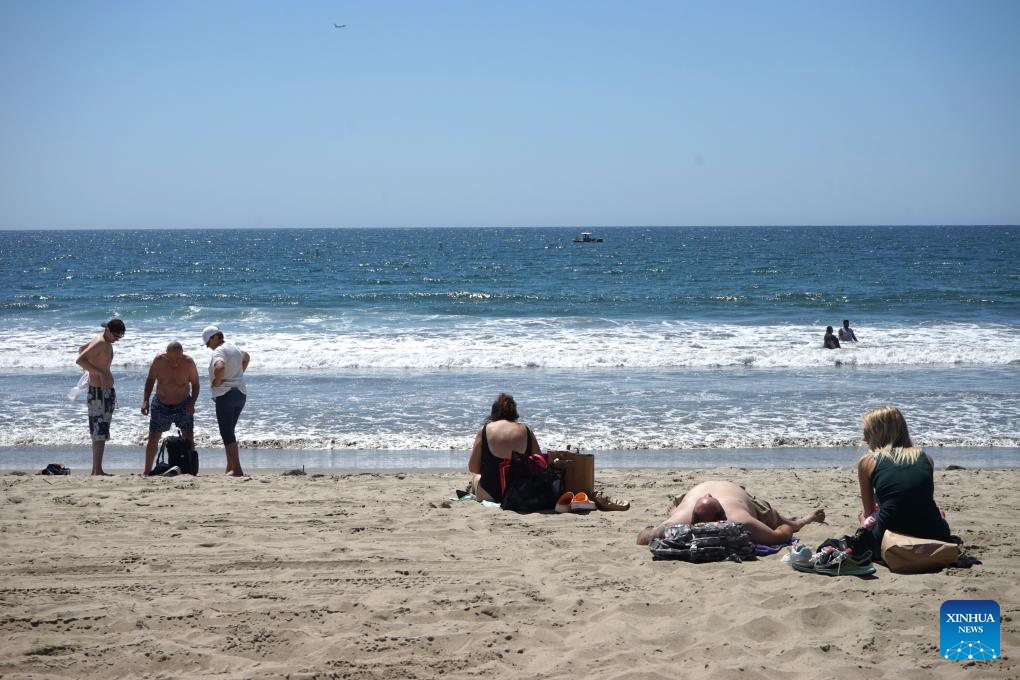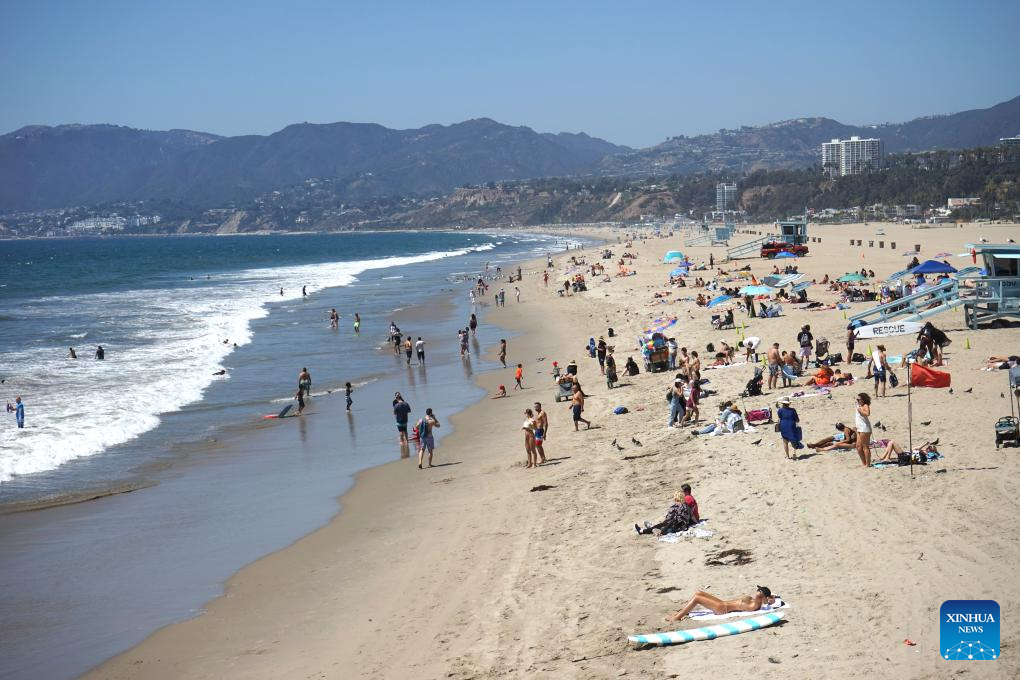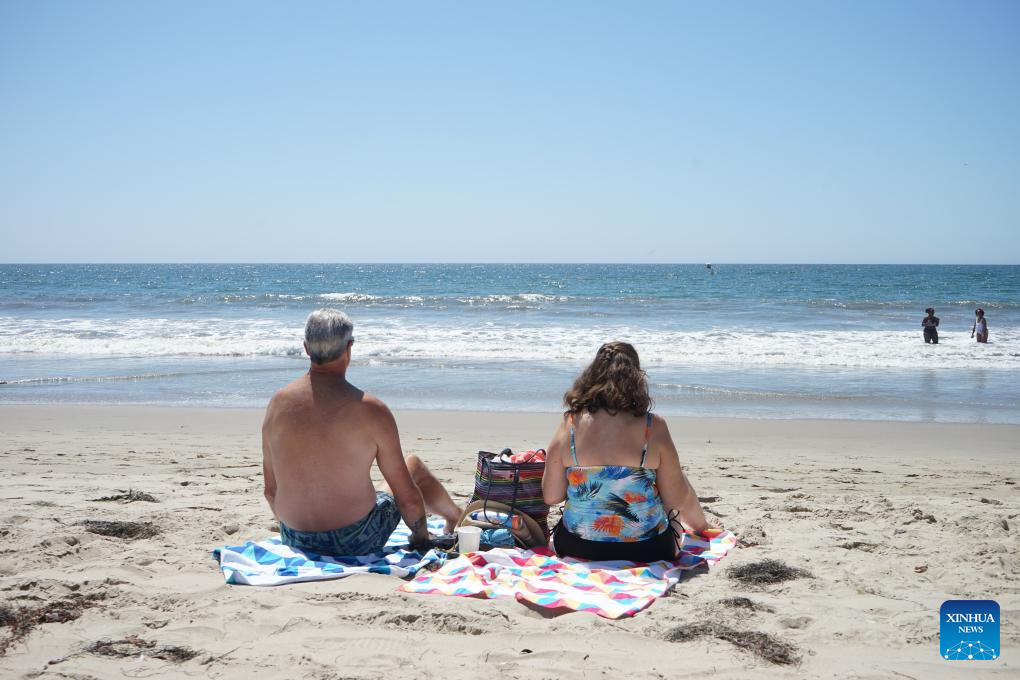
People cool off at Santa Monica beach in Los Angeles, California, the United States, Sept. 4, 2024. As summer draws to a close, cities across the western United States are still reeling from unprecedented heatwaves that have shattered long-standing temperature records and pushed communities to their limits. (Photo by Zeng Hui/Xinhua)
SACRAMENTO, the United States, Sept. 4 (Xinhua) -- As summer draws to a close, cities across the western United States are still reeling from unprecedented heatwaves that have shattered long-standing temperature records and pushed communities to their limits.
From Phoenix, Arizona, to Las Vegas, Nevada, to Death Valley in California, the relentless heat has challenged daily life, strained infrastructure, and raised alarm bells about the intensifying impacts of climate change.
With the high temperature exceeding 110 degrees Fahrenheit (43.3 degrees Celsius) at Phoenix Sky Harbor Wednesday afternoon, the number of days showing 110 degrees Fahrenheit or above for the year ties last year's record at 55 days, said the National Weather Service (NWS) Phoenix in a social media post on Wednesday.
"Expect a new record to be set tomorrow," said the agency on Wednesday, while forecasting that temperatures over the next three days will be "well above normal."
On Tuesday, Phoenix residents marked a grim milestone as the city endured its 100th consecutive day of temperatures reaching at least 100 degrees Fahrenheit (37.8 degrees Celsius).
According to local media, this streak has far surpassed the previous record of 76 days set in 1993. "The streak is expected to continue, with no end currently in sight," the agency said.
The extreme temperatures have taken a deadly toll, and in Arizona's Maricopa County, which includes Phoenix, public health officials reported 150 confirmed heat-related deaths as of Aug. 24, with another 443 under investigation. Last year, the county recorded 645 heat-related deaths.
Las Vegas also experienced its hottest summer on record.
The city's average daily high temperature for June, July, and August reached a scorching 107.6 degrees Fahrenheit (42 degrees Celsius), surpassing the previous record set in 1940. On July 7, Las Vegas hit an all-time high of 120 degrees Fahrenheit (48.9 degrees Celsius).
The heat has been particularly deadly in Nevada's Clark County, which includes Las Vegas. Officials have confirmed 181 heat-related deaths so far this year, with the actual toll likely much higher due to ongoing investigations.
Death Valley National Park, known for its extreme temperatures, recorded the hottest month ever measured on Earth in July, with an average temperature of 108.5 degrees Fahrenheit (42.5 degrees Celsius). The park reached at least 120 degrees Fahrenheit (48.9 degrees Celsius) on 37 days during this summer.
As September begins, there seems to be little relief in sight. The NWS Climate Prediction Center forecasts a 60-percent to 70-percent chance of above-normal temperatures for Las Vegas through at least mid-month.
High temperatures are expected this week across the western United States, with excessive heat warnings issued for parts of southern California, Arizona, and Nevada, where temperatures are expected to peak from Wednesday through the weekend.
In Los Angeles, temperatures could approach 100 degrees Fahrenheit (37.8 degrees Celsius), with inland areas potentially reaching 110 degrees Fahrenheit (43.3 degrees Celsius) or higher this week. Palm Springs and other desert cities in California are bracing for multiple days of temperatures exceeding 43.3 degrees Celsius.
Scientists attributed these extreme heatwaves to human-caused climate change, which elevates the risk of dangerously high temperatures across the globe.
The U.S. West has been hit hard by an unprecedented heat wave this year, with the prolonged heat straining energy grids, disrupting daily routines, and posing significant challenges for vulnerable populations.
In cities like Las Vegas and Los Angeles, cooling centers have been opened to provide refuge for those without air conditioning, particularly the homeless. Residents are advised to drink plenty of water and limit their time outdoors, especially during the afternoons. Local authorities also urged residents to check on neighbors, especially seniors and at-risk individuals during the heat wave.
The extreme temperatures heightened wildfire risks across the region as well. Oregon has seen more than 6,000 square kilometers burned by mid-August, the most of any state this year. California has been battling the Park fire, the fourth-largest wildfire in state history, since mid-July. ■

People cool off at Santa Monica beach in Los Angeles, California, the United States, Sept. 4, 2024. As summer draws to a close, cities across the western United States are still reeling from unprecedented heatwaves that have shattered long-standing temperature records and pushed communities to their limits. (Photo by Zeng Hui/Xinhua)

People sit at Santa Monica beach in Los Angeles, California, the United States, Sept. 4, 2024. As summer draws to a close, cities across the western United States are still reeling from unprecedented heatwaves that have shattered long-standing temperature records and pushed communities to their limits. (Photo by Zeng Hui/Xinhua)



